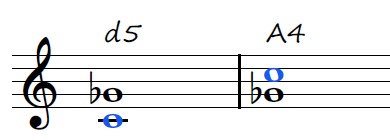Salford Piano Studio
When we move the bass note of an interval an octave higher, we have inverted it.
Since there are only two notes in an interval, there is only one inversion possible.
For Example, let’s take a Third (C-E):
By moving the C an octave higher, we now have a Sixth (E-C):
Let’s go over the different inversions.
Interval Pairs
There’s perfect symmetry in interval inversions – pairs of intervals invert one into the other.
As always, we start with C to make it simple.
Second/Seventh
A Second inverts to a Seventh.
C–D (2nd) | D–C (7th)
A Seventh inverts to a Second.
C–B (7th) | B–C (2nd)
Third/Sixth
A Third inverts to a Sixth.
C–E (3rd) | E–C (6th)
A Sixth inverts to a Third.
C–A (6th) | A–C (3rd)
Fourth/Fifth
A Fourth inverts to a Fifth.
C–F (4th) | F–C (5th)
A Fifth inverts to a Fourth.
C–G (5th) | G–C (4th)
Unison/Octave
Note how we cannot invert a Unison or an Octave.
A Unison will remain exactly the same, as it’s made of the same two notes.
If we try to invert an Octave, it will result in a higher Octave.
Interval Quality
So far, we’ve dealt with generic interval inversions.
Let’s examine the interval quality as we invert.
Perfect Intervals
Perfect Intervals remain the same.
A Perfect 4th inverts to a Perfect 5th and vice versa
Major/Minor
Major intervals invert into Minor intervals and vice versa.
For example, a Major Third inverts to a Minor Sixth.
C–E (M3) | E–C (m6)
Augmented/Diminished
Like Major and Minor intervals, Augmented and Diminished intervals invert one into the other.
For example, Diminished Fifth inverts to an Augmented Fourth.
C–G♭ (D5) | G♭–C (A4)

Example
Beethoven’s 3rd Piano Sonata starts with thirds in the right hand.
In the two bars below, he ends the phrase with a Sixth.
The last two intervals are an inversion: Major 3rd – Minor 6th.
